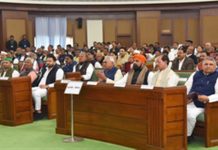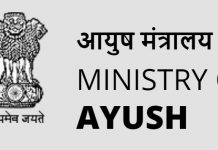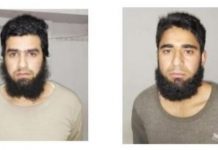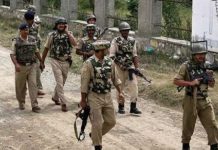On a summer night in 2017, when a family in Chhatarpur, New Delhi went to sleep after dinner, 14-year-old Mukti (name changed) discreetly slipped out of the house and ran. She was wearing worn out clothes and slippers, her hair was messy and she didn’t have a single rupee in her pocket. The dimly-lit street was empty and she fastened her pace as mixed feelings of fear of being caught and anxiety about her future ran down her spine.
As she reached the main road, drenched in sweat and tears, Mukti saw an autorickshaw and requested its driver to drop her to the New Delhi Railway Station from where she planned to catch a train back to her native place in Assam. The railway station was the only place familiar to her in the city because that is where she had ended up with her ‘agent’. Upon being dropped at the station, she caught a policeman’s attention who took her to a children’s home after she narrated to him her harrowing story.

In March 2017, Mukti was trafficked from Baksa district in Assam by a placement agent, a man from her neighbouring village. Early one morning when her mother left for work in a tea garden, the man, unknown to her, coaxed her to leave with him immediately saying her mother had given him permission to take her to Delhi for work as a domestic help. Upon reaching New Delhi Railway Station, she was handed over to two men named Rajiv and Arun who took her to their ‘office’.
There, she was confined to a small dark hall full of other trafficked girls. There was only one tiny window, too small to allow sufficient light or air inside. She felt helpless and trapped like the other young girls as none of them knew their fate. What was most shocking for Mukti was that during the night, the ‘agents’ would come to their room and force themselves on some girls.
When Mukti narrated her ordeal to Tehelka, it had been only two days since she had returned to her home state. She was residing at a children’s home run by the Assam Centre for Rural Development (ACRD).
“The agents were bad people. I was so scared to see how the agents would break into our room during the night and do bad things with some girls who were a little older than me. There were three more girls from different villages of Baksa, all tricked by such agents, just like me.”
She continued, “On the third day, late in the night, the agents took me to a Punjabi family in Chattarpur. Uncle and aunty used to beat me, hit me on my head, pull my hair and verbally abuse me. I would weep for hours. They would wake me up at 4 am to do the household chores, all by myself. They had a washing machine, despite that they would ask me to hand wash piles of clothes. They made me sweep and mop the entire big house. From 4 in the morning to dusk, I was constantly forced to work.”
Mukti also said that her ‘employers’ would give her just tea and two biscuits in the morning, lunch at 3 pm that included two chapatis and some sabji, and a small meal at night, though often there was no dinner for her.
After finally finding a safe place to live, Mukti wants to join school and continue playing her favourite sport, football, as early as possible. Back in her village before the incident happened, she and her friends would practice football everyday guided by a coach for free. Now, Mukti will be receiving education and rehabilitation at the children’s home run by ACRD till she desires. She hopes for a better future for her two younger sisters as well.
Trafficking scenario in Assam
Trafficking is flourishing in the rural and remote heartlands of Assam on an unprecedented scale. Minor children, especially girls, are targeted by traffickers and taken to metro cities to be engaged as domestic helps or in prostitution.
As per the National Crime Records Bureau (NCRB) annual report titled ‘Crime in India, 2015’, 1,494 cases of trafficking were reported from Assam in 2015, the highest in the country. This number took a sharp dip in 2016, falling as low as 91 in terms of cases reported. However, activist groups engaged in this area argue that the drop might not reflect the ground reality.
“The numbers show only cases that have been reported. But, as seen in many instances, most of the cases go unreported either due to ignorance or threats faced by parents and guardians,” said an activist who did not want to be named. Further, Tehelka’s investigation revealed some shocking details about a laissez-faire situation for criminals involved in human trafficking in the state.
Due to lack of education and awareness, parents readily give away their children when traffickers pretend to offer free education or lucrative jobs
No missing complaints
Perhaps the biggest advantage that traffickers have is that most cases go unreported. For instance, two minor girls — Bandani Nag and Bilu — went simultaneously missing from their village Dekadong in the state’s Baksa district in 2017. While it was later ascertained that an agent name Dasharat, a resident of Dekadong village itself, was responsible for trafficking both of them to Delhi, no action could be taken against them as the families of the missing children never filed a case against the accused.
When asked by this correspondent why they did not report the matter to the police, a confused and ignorant Birsa, brother-in-law of Bandani Nag, said, “Didi, police complaint? Nobody told us that we should complain to the police. We people do not have a single clue about whom to contact or complain when such a situation arises.”
It is indeed shocking that in Baksa hundreds of such trafficking cases go unreported and, hence, unsolved. In Doomni, a tea estate in the district, one in every two houses has a case of missing children or trafficking that is mostly unreported. This basically stems from the fact that most parents are not even aware that a complaint could be made to the authorities in the first place. In fact, trafficking in Baksa has increased two-fold over the years because almost 90 per cent parents do not file a police complaint, thus no First Information Report (FIR) can be initiated, when somebody goes missing.
Tehelka inquired with Officer-in-Charge (OC) Pabitra Kalita, Mushalpur Police Station, about why such a large number of people fail to report or file a complaint at the time of the incident, to which he replied, “Locals are reluctant to file a report, first, fearing a complaint to police will incur them a fee, and second, lack of evidence to prove a matter.”
“In most of the cases, we (police) press the families to file a report or at least acknowledge the offender; failing to do so makes the case frail to investigate further. We have been doing timely campaigns and mass-awareness programmes on human trafficking with support from CWC (State Child Welfare Committee), NGOs and student unions,” Kalita added.
Among the four tea gardens in Baksa district, namely Doomni Tea Estate (TE), Nagrijuli TE, Menaka TE, and Fatemabad TE, trafficking is at its peak in Doomni, which has a predominant population of tea labourers. Awareness among them about filing a missing complaint to police, or reporting to the administration, to Gaon Bura (Village head) or NGOs is almost nil.
As told by Kalita, there have been some campaigns, drives and mass-awareness programmes by the local authorities, student union groups beside NGOs, and the Child Welfare Committee (CWC). However, such initiatives have failed to sensitise the locals about the gravity of the matter.
Ethnic riots in the state in 2008 and 2012 resulted in the upsurge of trafficking to double. Riots make it easier for traffickers to exploit the oppressed population and smuggle children effortlessly from camps
Baksa is an administrative district under the Bodoland Territorial Council (BTC) in North-Western part of Assam. On February 10, 2003, the BTC accord was signed to form BTAD (Bodoland Territorial Autonomous District) with four districts — Kokrajhar, Chirang, Baksa and Udalguri. The sex ratio in Baksa is 974 females against 1,000 males. In general, Baksa is predominantly inhabited by Bodos followed by Kachari, Assamese, Adhibasi (Adivasi), Sarania-Kachari, Koch-Rajbonshi, Bengali and other religious minorities, as per government data.
Remote villages are haven for traffickers
Around five hours’ drive from Baksa is Kokrajhar district, which is the sixth-worst trafficking zone in Assam. On an average, one child goes missing or is trafficked from Kokrajhar everyday, according to NGO North East Research and Social Work
Networking (NERSWN) that works towards the education and betterment of underprivileged children in the area.
According to NERSWN, over 300 forest and border villages in Kokrajhar are susceptible to serious child trafficking as the government is fearful of entering these deep pockets. The main targets are children from the Santhali, Adhibasi and Bodo communities. Most of these children are trafficked to Delhi due to the high demand for domestic helpers and sex workers, and also to Haryana, Kerala, Gujarat, Mumbai, Punjab as well as several other parts of North and South India. Here again, the number of parents filing missing complaints with the police is miserably low.
Porous gateways to neighbouring Bhutan, Siliguri, Cooch Bihar and West Bengal help traffickers with easy escapes for smuggling of young boys and girls and makes Kokrajhar a haven for cross-border trafficking. Not only this, traffickers target soft spots like Deosri, Dadgiri and other untouched villages in Chirang district.
Human trafficking has been rampant in Kokrajhar. However, the ethnic riots of 2008 between Bodos and Adivasis and 2012 riots between Bodos and Bengali speaking Muslims resulted in the upsurge of trafficking to double. Almost 4,00,000 people from 400 villages got displaced in the riots of 2012. One would still find relief camps running in Kashugaon, Karigaon and other areas in Kokrajhar, some running since the 1980s, inhabited by Santhali and other displaced people. The riots make it easier for traffickers to exploit the oppressed population and smuggle children, both young boys and girls, effortlessly from such camps.
When Chancharang Narzary was trafficked in June, 2015 for bonded labour work from his village Sorupara, he was 14-years-old and studying in the ninth standard. The accused named Romesh took him to Guwahati, on the pretext of getting him a good job and better lifestyle and Rs. 2,000 as monthly salary in the hotel industry. His 53-year-old mother, Romphan Narzary, went berserk when she didn’t hear from her pisala (son) for two years. Today, Chancharang is back to home after he finally managed to flee in September 2017.
“Romesh took my son and after that there was no word from him (Chancharang) for two years. He was forced to do menial and tedious jobs at a small hotel. And, he was never paid a single salary in two years. I had a horrendous time away from my son for two years. What and how he was doing, alive or dead, I had no idea. I am happy he has returned. We are poor people. We will see what we can do for him so that he doesn’t have to be desperate again to earn money,” his mother said.
Another distressing story is that of 15-year-old Korobi (name changed). Never in her wildest dreams had she thought that her visit to a nearby village market would cost her her childhood.
[box]
Assam
2016:
91 cases reported
Total 249 victims trafficked (163 females and 86 males);
92 victims rescued (63 females and 29 males);
Assam stands at 11th position in all-India rank on trafficking;
Purpose of Human Trafficking: Forced Labour (36), Sexual Exploitation for Prostitution (51), Domestic Servitude (5);
Cases convicted by Court: 0
(Source: NCRB report 2016)
2015:
1,494 cases reported
Assam was at top in all-India rank based on trafficking.
(Source: NCRB report 2015)
Missing children
Total 2,413 children were missing till 2016 (1381 in 2016 and 1032 in previous years). Among them were 1,474 girls and 939 boys.
(Source: NCRB report 2016)
From 2012 to 2014 (October), a total of 4,754 children were still untraced in the state.
(Source: ASCPCR report 2016)
Some Missing cases of Baksa
Bandhani Nag, Bilu, or Deepti Kachwa (16) went missing in March 2017 Anita Toppo (30) went missing in September 2017. Sheila Eka (age 14, at the time she went missing in 2012) Sunita Lakra (age 14, in 2010 when she was reported missing) Chandani Lakra (age 15, in 2009 when she was reported missing)
[/box]
Bottlenecks
1. Lack of data with regard to child protection
2. Lack of awareness about child protection issues and services among other key line departments & mechanisms to tackle it among the public and other line departments
3. Lack of infrastructural and educational facilities
4. Lack of knowledge among officials on their functions and minimum convergence between government officials
5. Lack of specially trained manpower
6. Destination coordination problems: Police is given the responsibility to bring back the children but they don’t have funds for such cases of reintegration and family reunification.
(Source: ASCPCR report 2016)
Korobi was trafficked from Siliguri to Kokrajhar, that are apart by a distance that can be covered in three-and-a-half hours via train and six hours by road. In 2016, Korobi and her friends went to a local market where two unknown men gave her some eatables laced with sedatives that made her unconscious.
After that, she was abducted. Korobi, who had to go through a harrowing experience of sexual exploitation for almost a year, sounded terrified as she narrated her ordeal. “Those men gave me something to eat which made me
unconscious. I tried to resist but they gagged me, preventing my cries from reaching anyone’s ears. I was handed over to a man who kept me at his house in Gosaigaon. I was told that I will be sent to work as a domestic servant, but I was sexually abused and beaten.”
While trapped by her traffickers, Korobi would plan her escape every single day.“Finally, one day I somehow managed to use the phone. First thing I did was call my brother, then the police who eventually rescued me. Manuh bilak beya asil (They were bad people).” Korobi is currently undergoing counselling and is enrolled in a school run by Kokrajhar-based NGO called NEDAN Foundation.
The trafficking scenario in Kokrajhar is quite gloomy. According to NEDAN Foundation, almost 16 minor children, all in the age group of 10 to 17 years, went missing in 2016-17. Among the missing are Muslim and Bodo children. Such cases are not even reported by the mainstream media.
Tehelka also found out through the locals that from 1998 to 2016, children in large numbers were trafficked from the district to Gujarat, Kerala, Punjab and other parts of India, on the pretext of being given an education. According to a source, the ‘agents’ targeted families that were victims of ethnic conflicts, displacement, unemployment, poverty, etc.
On condition of anonymity, one of the parents whose minor daughter was trafficked in the name of getting an education expressed fear of never getting to see her again. “They threatened my daughter many times. If they find out that you (this correspondent) came to meet us, they might not send her back ever. Please, do something,” said the inconsolable mother who spoke to her daughter over the phone just twice in two years.
On the condition of anonymity, some locals talked to Tehelka and informed that more than 3,000 children have been illegally fished from Kokrajhar by some non-government educational institutions since 1998. “In the Northeast, it is a crime for the taker (persons or institutions), as well as for the giver (families) under the law, as per the Juvenile Justice Act, 2000, to take children under 14 years of age away from their parents and their culture,” one of them said.
Many parents are still hopeful of reuniting with their children from whom they haven’t heard for several years now.
Child Welfare Committee feels helpless
When Tehelka asked Moloya Deka, Chairman of Child Welfare Committee (CWC), Kokrajhar, to take a note of the matter, she shockingly asserted, “We (CWC) are aware of this fact and, yes, you are right, this is going on since 1998. But nobody can do anything.”
Expressing distress over the rampant child trafficking in Kokrajhar, she said, “Trafficking is rampant in Kokrajhar and this notorious menace cannot be stopped so easily, because the ethnic conflicts that led to the displacement of thousands of poor made them a prey for the traffickers. The traffickers in the name of recruitment agents run placement drives to lure thousands of poverty-stricken, displaced villagers to get in their traps. Usually, it is observed that either a trafficker is already known to the victim’s family or somebody from the same village or community does trafficking, not an outsider.”
Deka also said, “Level of education and awareness among the tribal communities, especially among the parents in Kokrajhar, is almost zero. This is one main factor why parents readily give away their kids when traffickers knock on their doors pretending to offer free education or lucrative jobs. This ignorance encourages traffickers to penetrate to porous pockets of BTC which are still untouched.”
60 missing girls of Chirang
In Chirang district of Bodoland, at least 50-60 girls have been trafficked in the past five years from the inaccessible forest village of Deosri, just 10-km away from Gelephu town in Bhutan. This was not the first time that Adivasi and Santhali girls from Deosri or Dagiri were trafficked to be engaged in bonded labour. In fact, there are hundreds of unreported cases from Chirang district.
The girls were in the age group of 14 to 24 when they were trafficked, and the numbers of trafficked girls could go up to 70 after thorough investigation, Tehelka learnt from the All Adivasi Students’ Association of Assam (AASAA) and All Santhal Students Union (ASSU).
“We have the information that bogus placement agents and some hotel owners from Gelephu town of Bhutan have taken the girls to work in their hotels as bonded labourers. Parents and families do not have the basic information like where their daughters are working, what kind of work they do or where they are,” said Ananta Murmur, vice-president, AASAA, Chirang district.
“Our sources told us that the girls are strictly restricted from leaving the hotels. Members of AASAA and ASSU went to Gelephu and tried meeting the girls discreetly by working in some of the hotels. “But they (the trafficked girls) refused to acknowledge us fearing backlash from the owners and feeling of shame (because of their involvement in forced sex work),” said Ananta.
[box]
Dealing with victims
After a trafficking victim (minor or adult) is rescued, what comes as the next level of challenge is counselling. Tehelka spoke to Gauri Goswami, Counsellor, Navajeevan home, ACRD, Assam, about difficulties in dealing with trafficked victims. On this she said, “Post the rescue operation, in the initial period at homes, victims are seen immediately isolating themselves from the world, while some get extremely aggressive. Their past experience even inflicts depression, mental illness, besides leaving scars of the past. It is essential that they are treated with utmost love and respect, feel secure in the homes.” Working since 2009 at Navajeevan, Goswami said, “We help them indulge in recreational activities like singing, yoga, dance, craft work and various hobbies; participate in community-level programmes.”
[/box]
Most of the trafficked girls have the same background – extreme poverty. For example, 14-year-old Miru Hasda from Hatisar, who is among the 60 girls trafficked from Chirang. She was forced to be a full-time domestic servant to a family in Gelephu. The Bhutanese family had allegedly taken her by promising a salary of Rs.2,000 per month to her family. According to her relatives, Miru had been taken to Gelephu by her current employer six months ago, but after constant abuses hurled at her, she fled and returned home. Her happiness was, however, short-lived. The Bhutanese family returned to force her back to Bhutan and work for them. Extreme poverty led Miru’s parents, Lalchand Hasda and Barki Mandi, to give away their minor daughter to the family, but, they haven’t received any money yet. The parents are also reluctant to complain to the authorities.
Here, the bigger question is how the girls manage to reach Geluphu by crossing the India-Bhutan border despite tight security being deployed round-the-clock to safeguard the border gates and check upon any illegal activities.
On this, Ananta said, “Now, this is a critical question, how cross-border trafficking could happen in spite of such tight security at the border gates. It is to be noted that there are labour unions stationed at the border gates who record details of every single migrant labour coming to India or Bhutan for work on a daily basis. Without their permission, no migrant labour can come to India or cross towards Bhutan to work.
But the agents are too smart. They use hotel vehicles that have vehicle registration plates of Bhutan while entering India. Usually, hotel vehicles with Bhutanese registration plates get a go ahead at the border gates, therefore, they easily enter the poor border villages of Assam, pick up the girls and return to Bhutan.”
He further said, “Thankfully, the Royal Bhutan Police (RBP) is very cooperative. But, it is unfortunate that every time Bhutan Police raids the hotels on tip-off from their sources, the hotel owners transfer the girls to undisclosed locations before the authorities can reach them. There is a nexus between hotel owners and agents, where the agents act as informers to such hotels.”
AASAA and other student unions are working relentlessly to chalk out a plan to dig out details of all the girls and bring them back home, with the help of NGOs and other concerned authorities. They are also drawing plans to sensitise parents to curb the menace.
It is seen that the Santhal and Adivasi communities in Lower Assam have been severely targeted by the traffickers, time and again. The level of ignorance is high and education level is absolutely zero. At least in the case of the Bodo community, trafficking has come down to some extent. Bodo students union has been mobilising Bodo people to educate them on the issue of trafficking through timely interaction with parents and intervention. The same action is, sadly, missing in the far-flung border villages situated near the Indo-Bhutan border.
Low conviction rate of traffickers
As per reports from Assam, everyday four children go missing and among them girls are the top victims of this nefarious human trafficking trade.
Digambar Narzary, Chairman, NEDAN, highlighted that less number of convicts in trafficking cases is a problem too. “NEDAN has put 45 traffickers behind the bars and only four have been convicted. Such is the case here. This encourages culprits to move freely sans fear and continue with trafficking.”
NEDAN started a national campaign called ‘every 8 minutes a child goes missing in India’ on missing children to stop child trafficking in the country. The NGO has been encouraging the locals to come out and report such cases without being named.
For this, NEDAN started an SMS service to keep a track on trafficking cases or those of missing people in Kokrajhar, Chirang and other border and remote forest villages. Anybody with a basic mobile phone can inform NEDAN about such incidents by calling or sending a message to 9229224424. According to Rajeev Sharma, Director of Guwahati-based NGO GOLD (Global Organisation for Life Development), the number of trafficking victims is much higher in reality considering actual reported and unreported cases from every nook and corner of Assam.
“In reality, approximately, 10,000 women and children are trafficked each year from Assam. Also, there is no significant increase in conviction of the traffickers which has made the trafficking a risk-free business. It is very much required to strengthen the Anti-Human Trafficking (AHT) task forces in the police stations through various training and awareness programmes.”
Since its inception in 1998, GOLD has facilitated approximately 50 rescue operations with police and rescued 500 victims.
Assam Centre for Rural Development (ACRD), a noted organisation working for trafficking victims, especially in the porous pockets of Baksa and Udalguri districts of Assam since 2009, said that as per their data, 171 girls have reportedly been trafficked from Baksa and Udalguri since 2009.
Prerna Changakakati, Director, ACRD, said, “There is no database to monitor inter-state migration, as a result, there is no tracking of the girls who go missing.
The state needs stringent laws to safeguard victims, bust the nexus and punish the traffickers. Also, better employment opportunity should be created to prevent re-trafficking of rescued children and women from Assam. The government should also release sufficient and timely funds to organisations working on rehabilitation of trafficked victims.”
Policy needed for human trafficking
Poverty is not the only factor behind the increasing number of trafficking cases in lower Assam. Lack of awareness among adolescences has kept the human trafficking trade alive in the state. “Today, young boys and girls aspire to go out, earn money and experience a better lifestyle, but they do not know how to earn it. This is the reason why
many children and youths are easily lured by traffickers,” said Dr Sunita Changkakati, Chairperson, Assam State Commission for Protection of Child Rights (ASCPCR).
However, while trafficking cases persist, surprisingly there are no specific policies to curb the menace. When asked about the programmes to control trafficking situation in Assam, the Chairperson said, “ASCPCR is planning to formulate a policy to combat trafficking.”
letters@tehelka.com













